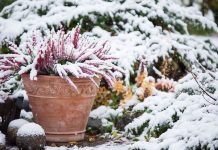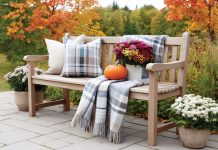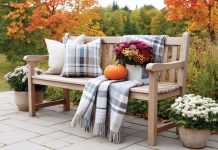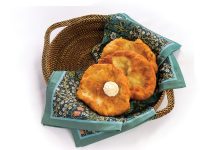Combining her love for design and plants into her business A Lavender Garden, Master Gardener Amanda Pratt offers home horticulture consults, landscape design, and one-on-one Utah-based gardening education—with a focus on sustainable practices, water-wise plants and soil science. At her charming Millcreek home, she keeps chickens and bees while nurturing a 2000-square-foot garden where she plants just about anything that will grow in the high desert. This autumn, she offers tips to make the most of your gardens this season and beyond.
Prepare your garden beds
Begin by getting a soil test from U.S.U. Analytical Laboratory (Click here for instructions). Apply the recommended nutrients and organic matter. Fall preparation allows the microorganisms to build in the soil for spring planting.
Add a layer of organic mulch
Soil Pep (decomposed pine that adds nutrients to the soil) protects your soil and keeps spring weeds down. It also conserves moisture and helps plants survive the winter.
Plant cold-hardy crops
Choose varieties that can withstand some frost, including kale, lettuce, broccoli, spinach, peas, radishes, carrots, beets, Swiss chard, turnips, kohlrabi and cabbage. Extend the harvest with the protection of a low tunnel, floating row covers or a cold frame. Plant garlic, green onions and leeks for a spring crop.
Enhance your landscape
Add trees, shrubs and perennials now for more robust plants and stronger root systems next spring. Plant at least 3-4 weeks before the ground freezes to allow time to establish—no later than Thanksgiving. Water regularly.
Clean up
Cut back perennials and grasses in areas where access is needed. Remove plant material near structures to avoid moisture buildup and reduce insect and rodent pests. Destroy any diseased foliage, especially vegetable foliage that can spread fungal disease and viruses into the next year’s crops.
Sow cover crops
Mostly used for vegetable beds, cover crops add nitrogen to the soil, increase soil organic matter, suppress weeds, conserve soil moisture, reduce compaction and prevent erosion. Common varieties include clover, peas and hairy Vetch.
Plant spring bulbs
Extend the beauty by choosing varieties with different blooming periods so that when one flower dies out, another one emerges. Plant bulbs in holes three-times their height. For clusters of flowers, plant in groups of three to five bulbs.
Read more about gardening in all seasons here.






















